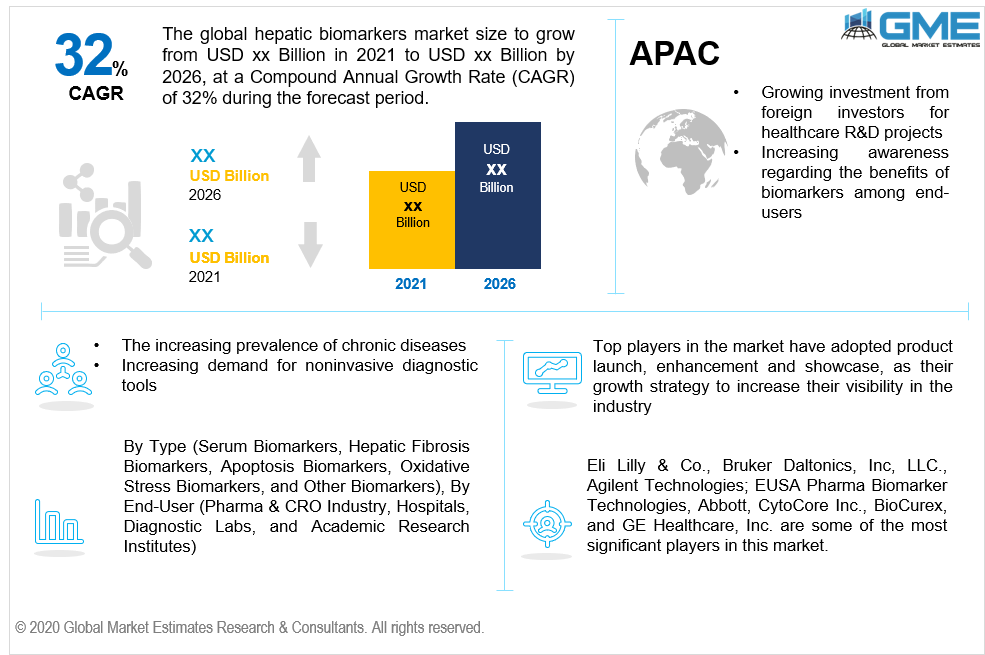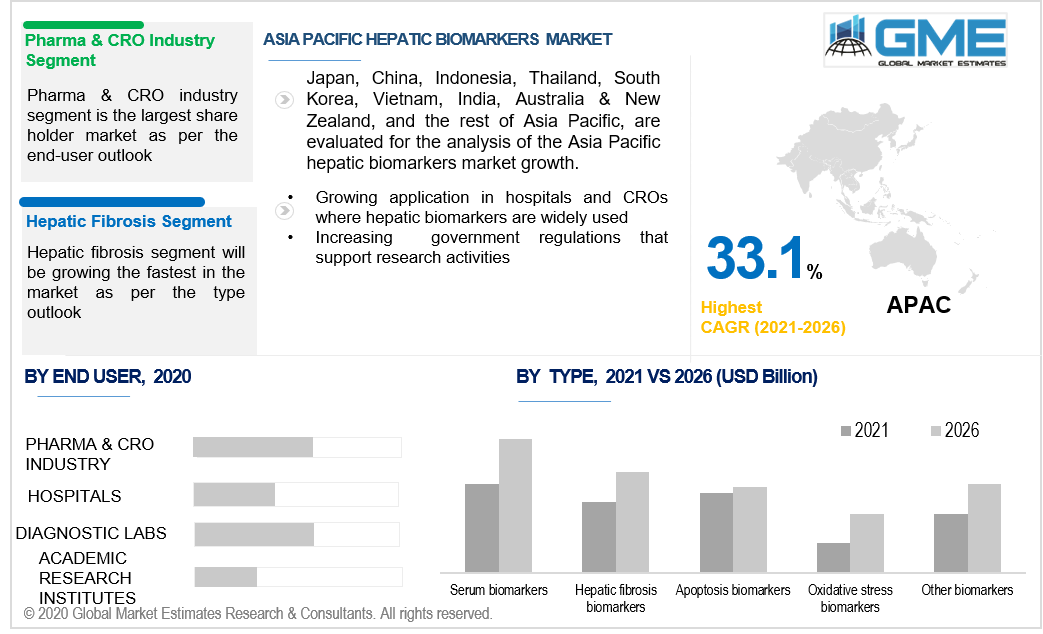
Global Hepatic Biomarkers Market Size, Trends & Analysis - Forecasts to 2026 By Type (Serum Biomarkers, Hepatic Fibrosis Biomarkers, Apoptosis Biomarkers, Oxidative Stress Biomarkers, and Other Biomarkers), By End-User (Pharma & CRO Industry, Hospitals, Diagnostic Labs, and Academic Research Institutes), By Region (North America, Asia Pacific, Europe, Latin America, Middle East & Africa), End-User Landscape, Company Market Share Analysis, and Competitor Analysis
The use of hepatic biomarkers is becoming more common as the global prevalence of chronic diseases rises. Increased investments in healthcare and pharmaceutical sector research and development programs are making these biomarkers more advanced and effective. Furthermore, the rising prevalence of chronic liver ailments which is associated with a high standard of living and heavy alcohol intake is projected to drive up demand for these biomarkers.
As biomarkers eliminate the need for risky procedures, such as biopsy, they are majorly favored by doctors and patients, which is expected to contribute to this rising demand. Imaging technologies such as, magnetic resonance imaging and ultrasound scanning have proved to be inefficient compared to these biomarkers, which is anticipated to be a prime factor behind the boost in the market demand for these extremely powerful diagnostic tools.

According to the type of hepatic biomarkers, the market can be segmented into five main categories, namely, serum biomarkers, apoptosis biomarkers, hepatic fibrosis biomarkers, oxidative stress biomarkers, and other biomarkers. Among these, serum biomarkers are estimated to be the market leader of this segment during the forecast period.
This type of biomarker is the most prominent as it is significantly used for the diagnosis of NASH. The fluid used in these biomarkers is capable of efficiently detecting and treating tumors. These are extensively used for the diagnosis of the lungs, breasts, prostate, colorectal, and ovaries. It is also an expert tool that helps in differentiating steatosis from a malignant cell, which makes it extremely popular in the global healthcare market.
Serum biomarkers also minimize the need for biopsy in the critical diagnosis procedure, which acts as a premium advantage of using this tool. This is an irreplaceable tool that is prominently used in the medical industry. Owing to this factor, it is expected to dominate this segment. Moreover, with the introduction of components like free fatty acids, apolipoprotein A-1, apolipoprotein B, leptin, adiponectin, etc. in the formulations of the serum biomarkers, the demand for such biomarkers is anticipated to rise in the forecast period.
On the other hand, hepatic fibrosis is expected to be the fastest-growing segment and owns the highest CAGR as it provides the most accurate and efficient results in the diagnosis procedure. Also, its affordability is a major factor that is increasing its acceptance among both doctors and patients.
According to the end-users of these biomarkers, the market can be segmented into four main categories, namely, the pharma & CRO industry, diagnostic labs, hospitals, and academic research institutes. The segment of the pharma & CRO industry is expected to be the largest shareholder in this market.
The need for medical care is rising in conjunction with the increased global population. Also, the increasing prevalence of complex medical issues is raising the demand for advanced diagnostic and monitoring tools. Globally, the number of diagnostic centers is increasing, which is eventually increasing the demand for hepatic biomarkers. Moreover, these biomarkers are applied for NASH diagnosis, which is a leading cause of the growing demand for hepatic biomarkers from the pharma & CRO industries.
The segment of academic research institutes is estimated to be expanding with the highest CAGR. With the emergence of the ongoing pandemic, the research and development projects for the creation of vaccines have gone up tremendously and it is expected to make the segment of academic research institutes grow at a steady rate during the forecast period. Moreover, there are many novel diseases for which drugs and vaccines are being developed with the help of these biomarkers. Thus, the aforementioned factors are expected to contribute to this rising demand for hepatic biomarkers.

As per the geographical analysis, the market can be classified into North America (the United States, Canada, and Mexico), Asia Pacific (India, China, Japan, Malaysia, Singapore, and Rest of Asia Pacific), Europe (Germany, United Kingdom, Italy, France, Spain, Netherlands, and Rest of Europe), Middle East & Africa (Saudi Arabia, United Arab Emirates, and Rest of the Middle East & Africa) and Central South America (Brazil, Argentina, and Rest of Central and South America).
The North American region is foreseen to be the leader in the global hepatic biomarkers market. Huge amount of investments are being made in the research and development activities of the healthcare and pharmaceutical industries which are contributing to the increasing demand for hepatic biomarkers in this region. Moreover, the favorable government policies about patient safety in medical care facilities are also making the healthcare sector extensively use biomarkers during the treatment of various diseases.
Along with this, the high standard of living of the regional population, the lifestyle and food choices are causing a surge in the prevalence of cancer and liver failure. This is leading to the rise in acceptance of hepatic biomarkers among both doctors and patients since it is less painful compared to other treatment options.
Asia-Pacific is predicted to be the fastest-growing market over the forecast period, with the highest CAGR. Huge investments from foreign investors are being received by this region. This is increasing the R&D projects being conducted to develop more efficient formulations for hepatic biomarkers. This is the main contributing factor for regional growth.
Moreover, developed countries of this region, like China and Japan, are expected to demand a large number of biomarkers due to the rise in the population suffering from chronic diseases. Moreover, to meet the increasing population's needs, many hospitals and CROs are increasing. These facilities are increasingly utilizing these biomarkers, which are eventually increasing the growth of the hepatic biomarkers in the APAC region.
Eli Lilly & Co., Bruker Daltonics, Inc, LLC., Agilent Technologies; EUSA Pharma Biomarker Technologies, Abbott, CytoCore Inc., BioCurex, and GE Healthcare, Inc. are some of the most significant players in this market.
Please note: This is not an exhaustive list of companies profiled in the report.
We value your investment and offer free customization with every report to fulfil your exact research needs.
The Global Hepatic Biomarkers Market has been studied from the year 2019 till 2026. However, the CAGR provided in the report is from the year 2021 to 2026. The research methodology involved three stages: Desk research, Primary research, and Analysis & Output from the entire research process.

The desk research involved a robust background study which meant referring to paid and unpaid databases to understand the market dynamics; mapping contracts from press releases; identifying the key players in the market, studying their product portfolio, competition level, annual reports/SEC filings & investor presentations; and learning the demand and supply-side analysis for the Hepatic Biomarkers Market.

The primary research activity included telephonic conversations with more than 50 tier 1 industry consultants, distributors, and end-use product manufacturers.

Finally, based on the above thorough research process, an in-depth analysis was carried out considering the following aspects: market attractiveness, current & future market trends, market share analysis, SWOT analysis of the company and customer analytics.

Tailor made solutions just for you
80% of our clients seek made-to-order reports. How do you want us to tailor yours?
OUR CLIENTS